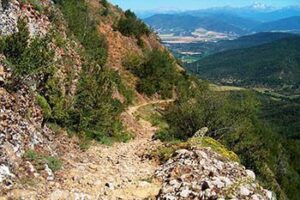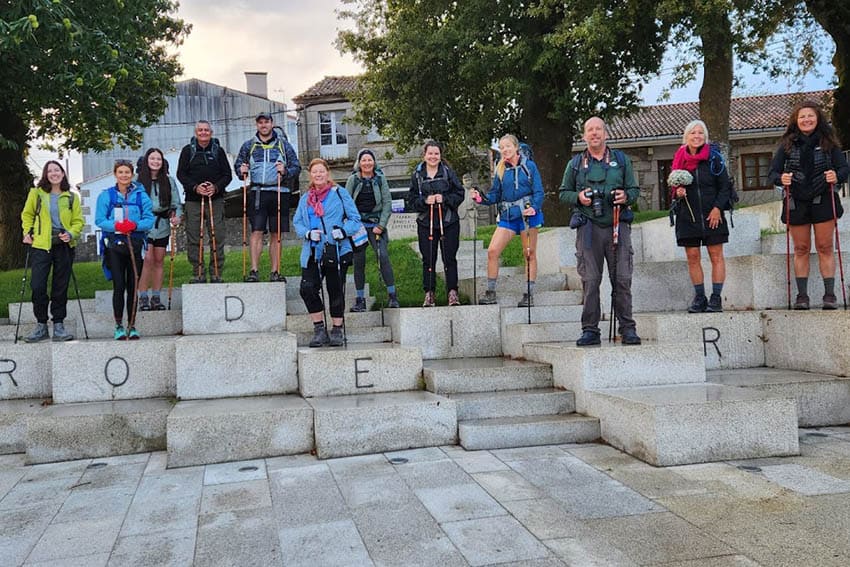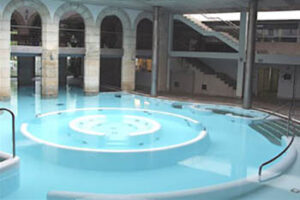
Camino Wine Tastings for Poseurs and Pilgrims
By Richard Frisbie
“Buen Camino” means “Good Camino”. It is the greeting pilgrims share as they pass on St. James Way, the medieval path through Europe to Santiago de Compostela and the Cathedral of St James, in Galicia, Spain.
The body of St James is interred beneath the altar. On my various trips along the Camino, I shared the greeting many times, but I was never there as a pilgrim. At best I was a voyeur, an interloper, an observer of the devout on their religious quest to St. James and salvation.
I was there to drink the wine and taste the food. As such a poseur I was one of many, for not all who travel “the Way” are pilgrims – at least not in the beginning.
There are many tales to tell from my travels. These three are about wine and friendship and serendipity and always center around the Camino.

Three Memorable Wine Tastings on The Camino
We were in the Bierzo section of Castilla y Leon, Spain, changing things up a bit by bicycling a portion of the Camino. True pilgrims walk the entirety, even some non-pilgrims do. Bicyclists can feel intrusive and rude to walkers, but we found it exhilarating to whiz up and down the rolling hills on rented electric bikes, shouting “Buen Camino” to the peripatetic, and stopping often to be tourists when something caught our attention, like crows attracted to shiny objects.
Yet the walkers persisted until we found ourselves passing the same pilgrims again and again as we “sped” on our way.

Stopping for refreshment, we followed our noses behind a shop selling coffee and pastry. There we found an open fire with just-harvested red peppers, the famous Spanish pimiento rojo, blackened and fragrant, roasting on the grills.
Of course, we bought some. They would become part of a picnic lunch and wine tasting planned for later at La Cabaña de los Pinos, or “My favorite place in the world!” according to Santiago Ysart, one of the five siblings who own Cantariña Vinos de Familia.
“La Cabaña” is an old hunting cabin on top of a hill corseted with grapevines, a lone dirt track twisting up through them from the main highway to the pine-shaded summit where we would taste the best wines of Bierzo.
“Santi” Ysart is an outgoing, big-hearted man who loves people almost as much as his wines, so we had a great visit in such a beautiful setting. One of the stories he told me I’ve repeated often:
As we looked out over the scenery from our vantage, he remembered as a child playing on the top of a hill on the other side of the highway. The hilltop was once ringed by the remains of a Roman fortification protecting the road to Las Medulas, the nearby Roman goldmines.

The fortress was built in turn on the site of an ancient Celtic encampment. We stood, drinking his excellent red and white wines, marveling at all the history laid out before us, imagining we could still see some stones even after the expanded vineyard had erased them decades before. Such is the power of memory, friendship, and good wine. Reluctantly, we bid Santi goodbye as the Camino beckoned.
Then, after lamenting that the wines we tasted were not available in the US and could only be enjoyed again if we returned, we descended from my most memorable wine tasting. Where one adventure ends another begins.
Several years later…
Ever the dilettante, I again found myself briefly on the Camino, walking this time, in a rain the Galician locals said was heavier than they were used to experiencing. They blamed climate change.
All I knew was that my rain gear was water-resistant in their usual light mist, but not waterproof in the downpour. I put a single-use plastic poncho on over four layers of wet and trudged on feeling more and more like a true pilgrim.
There are different Caminos all leading to Santiago de Compostela. We were following the primary one which is the French Way. In the winter there is a popular alternate spur south around the highest elevations to avoid much of the snow. Even though it was Springtime, we detoured down it just for the change in scenery. And what a change!
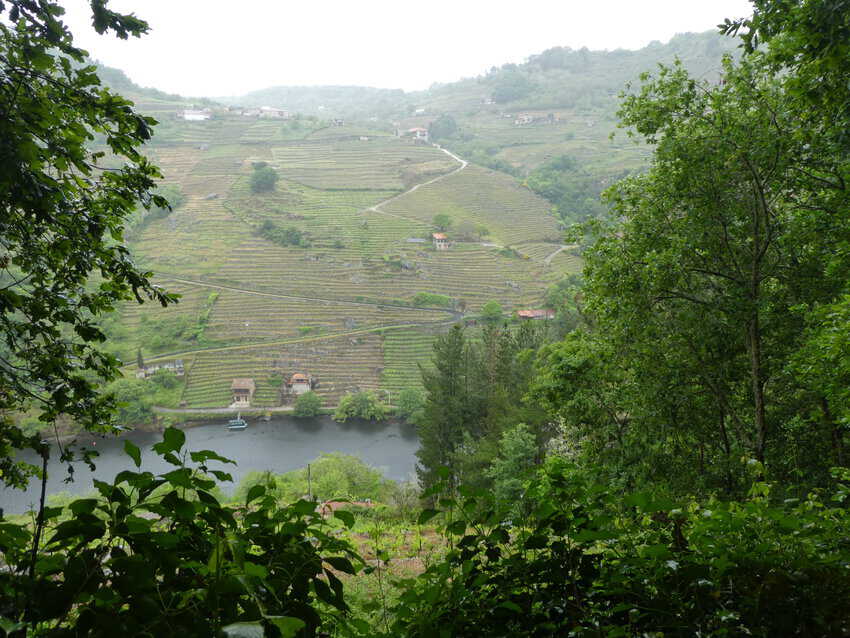
The Camino is a Medieval route, but this stretch followed a Roman road through a farmer’s dooryard to a gentle path coursing an old-growth forest. Everywhere was evidence of why Galicia is called “Green Spain.”
Everything was lush and verdant, covered in ferns, moss, and lichens – fairytale-like – dripping jewels of raindrops. Slowly the way steepened downward, the rocks the Romans used as pavement becoming treacherously slippery as the trail switch-backed down toward the Miño River which divides Galicia’s Lugo and Ourense provinces.
Spectacular views of the valley below appeared through the overgrowth as we descended, but I was reluctant to take my eyes off the precarious footing to admire them.
Centuries-Old Vineyards
We were entering an area of centuries-old vineyards, the vines terraced up the steep slopes from docks where the grapes were loaded onto boats for transport to processing. When we broke out of the forest our descent continued through terraces that mirrored the opposite hillside, ending at a dock where an electric boat awaited. The river was the highway, and we were going to a boat-only accessible wine tasting.
But not just any wine tasting. The vintner, Martin Martinez, reclaimed some old vineyards and restored a “Guardian Winery”, the Ecosacra. It is a winery in the old tradition of Ribeira Sacra that “conveys the true life of our ancestors and their authentic heroic viticulture.” He even has a small museum in his 14th-century tasting room, with some fine wines to share.
We glided noiselessly past steep hillsides with what looked like ladders periodically breaking the terraced vista. They were ingeniously installed rails designed to carry the harvest down to the dock. Martin told us it was tough to get laborers to tend the steeply terraced vines, but it would be impossible without the rails to minimize the climbing. Here in the Ribeira Sacra, the wine is known as “heroica” because of its difficulty with producing it. It gained its own DOC in 1997.
The rain stopped as we arrived at our tasting, but it was still too wet and iffy looking weatherwise to risk an alfresco repast on the patio. The reflection of the opposite terraces on the glassy water presented a beautiful view, but we retreated into the ancient stone structure repurposed from harvest storage into a warm and cozy tasting room.
A table awaited, laid with local cheeses and meats and glasses for the many wines. It was a second lunch as much as a tasting, and just what our soaked, chilled bodies needed.
Jamon Iberico Bellota
Two curious gastronomy notes surprised me. One, while Spain’s famous Jamon Iberico Bellota from acorn-fed pigs is produced south of here in the dryer areas of Extremadura, locally the pigs are fed the predominant nut – chestnut – instead, and the flavor subtlety changes.
It is a small thing, but noticeable. I’d have to linger here longer to tell you which I liked best, but for now, I’ll stick with the traditional acorn-fed jamon. The other culinary curiosity was a soft chorizo. It is simply too damp here to dry-cure the sausage to a typical chorizo consistency. It has a similar flavor but a whole different mouthfeel. They and the cheeses were delicious!
All the local foods were washed down with Martin’s red wines, both Toto and O’, a blend of Mencía, Brancellao and Merenzao grapes from a region originally cultivated by the Romans 2000 years ago (hence the road we walked in on).
The Romans were followed by monks who perfected the wines and the terraced growing methods. They are primarily young wines, but a few are being aged with good success. Naturally, because of the terroir, the wines paired perfectly with the local foods.
All-in-all, the hike, boat ride, and tasting were memorably refreshing, and the views extraordinary, but I would have enjoyed both so much more on a sunny day. https://www.sacraactiva.com/
And on yet another brief excursion on the Camino
We walked the Camino through the charming city of Villafranca del Bierzo. We explored the public gardens dotted with palm trees and formal plantings of iris, lily, camilla, peony, and roses all in early May bloom. What a fantastic climate!
Climbing the Camino up out of this protected Shangri-la we waited for the Marquis of the Castle of the Marqueses de Villafranca to arrive for a tour of his family’s sixteenth-century home overlooking the city.
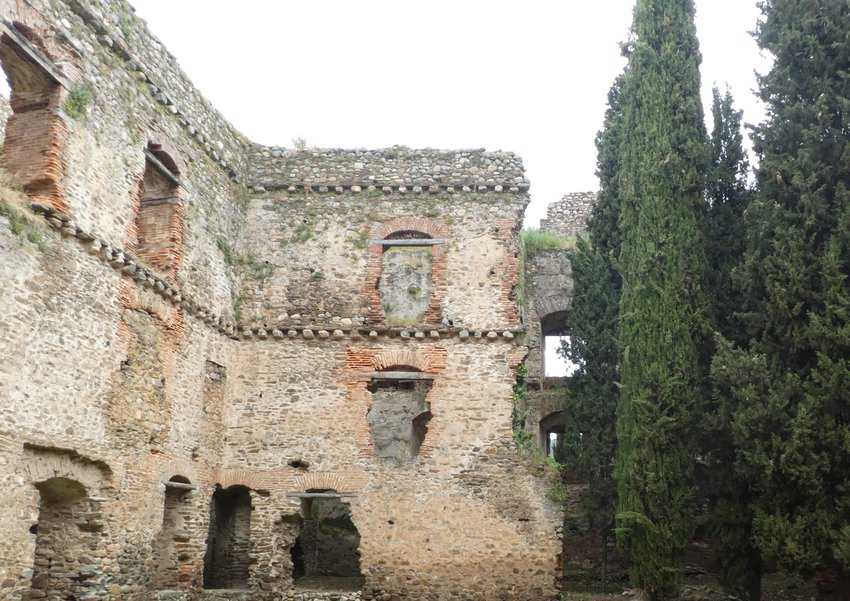
The castle is soon to be open regularly, but as often happens on my trips, this was a private preview of the gardens, vineyards, towers, and dungeon, with the owner Alonso Halffter, who also hosted a wine tasting in our honor.
Only a portion of the castle was rebuilt in the 1800s after it was looted and destroyed by the French. (The irony of the French army destroying a castle named Villafranca in a town with a large French population called Villafranca, on the French Way did not escape me.) A section of the formal garden remains, surrounded by grape vines.
Two of the four round towers on the corners of the square castle have been restored, as well as the living quarters. The exterior walls not visible from the street remain windowless shells surrounding a grassy courtyard. Still, because it has been lived in since the 16th century, it is the best-preserved castle in the entire Bierzo region.
The setting for the wine tasting was a cozy room warmed by a fire, the walls hung with paintings by his father, the famous Spanish composer Cristobal Halffter. Alonso only produces red wines under the name Castillo de Villafranca. There was a 2023 bottle, admittedly too young for drinking, but he offered it as a taste to show us where he was going with the process.
Then the smooth, lush 2009 vintage was brought out to show us what we could expect as the newer vintage aged. The traditional tempranillo grapes delivered moderate tannin and acid which made me appreciate the 2023 even more. It is a wine to own and put down for future enjoyment.
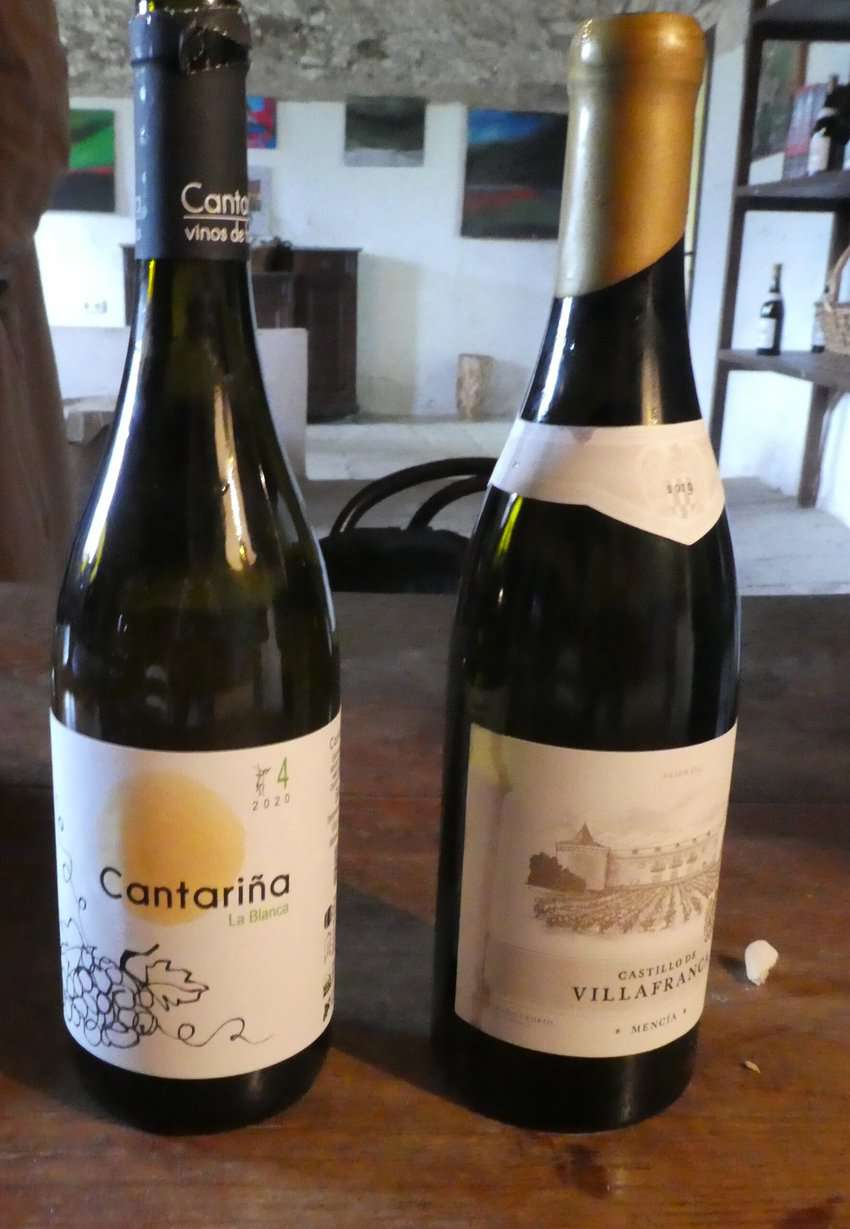
After tasting our host’s tinto selections, his companion offered the La Blanca wine she brought. While it is most unusual to taste a white after a red, in this case, it was just polite.
That was when I realized I’d tasted the white before and I knew why I recognized her!
Remember Santi Ysart, one of the five siblings who own Cantariña Vinos de Familia?
Consu is his sister! She was there on the pine-shaded hilltop serving family wines with her brothers all those years ago.
The taste of her fine white, fragrant and dry, crisp even, brought those memories of my favorite wine tasting flooding back to me.
Now I have two favorite tastings. And do you remember my lament that I could only taste these great wines here in Bierzo? Well, the post-pandemic good news is that they are starting to become available in the US now. Look for them in large wine stores and on restaurant wine lists.
All the Cantariña wines are organic, produced in harmony with nature, by a family honoring generations of viticulture with a true appreciation of their land. Wine tours and tastings can be scheduled.
Santi tells me he enjoys meeting people from all over the world to share his love of wine with them. When you go to Bierzo to enjoy a La Cabaña de los Pinos experience similar to mine, tell Santi I said hello!
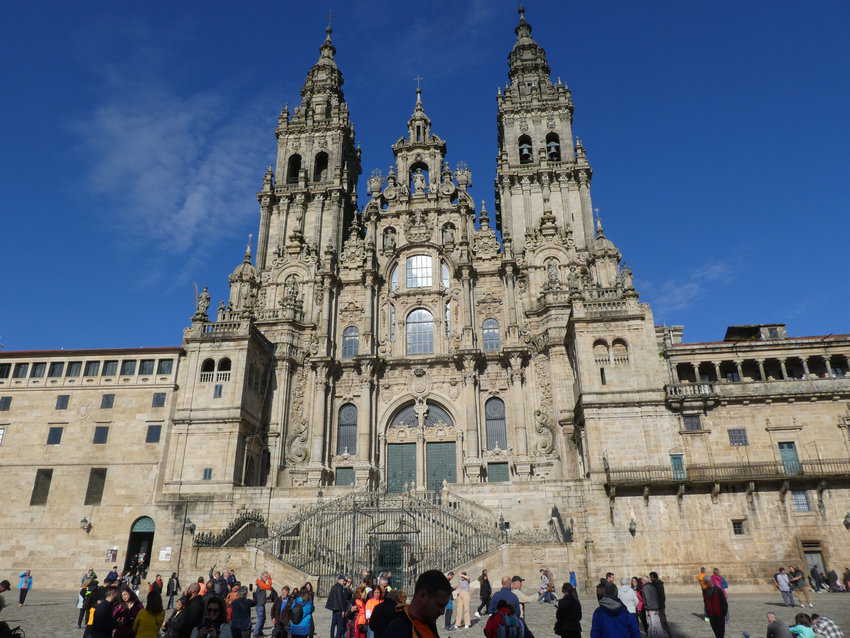
And for more Camino tales and wine tastings from my many trips to Spain, you can follow me here on GoNomad, or Instagram as #frisbierichard
Richard Frisbie is a retired chef who writes food & wine travel articles for major publications and anthologies. At home, he likes to recreate the tastes he encounters on his journeys. Follow him on Instagram: @frisbierichard for great adventures on the wine trails and foodways of the world.
Richard’s trip was sponsored by Tourism Spain but the opinions are all his own. Find out more about Castilla y Leon, Spain and Galicia, Spain.
- Arezzo, Tuscany: A Stunning Find - September 3, 2024
- Fall Clothing for Your Travels - August 30, 2024
- Mekong Chronicles: The River That Shaped Southeast Asia - August 28, 2024


